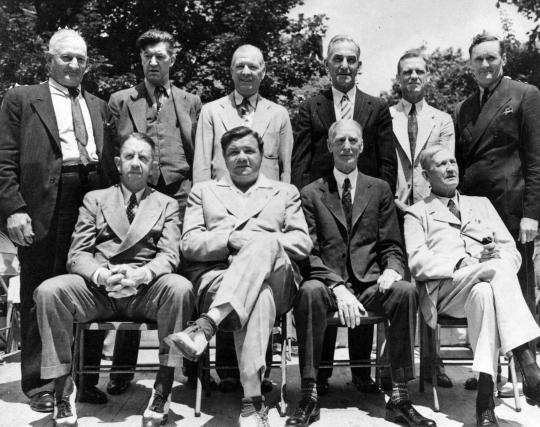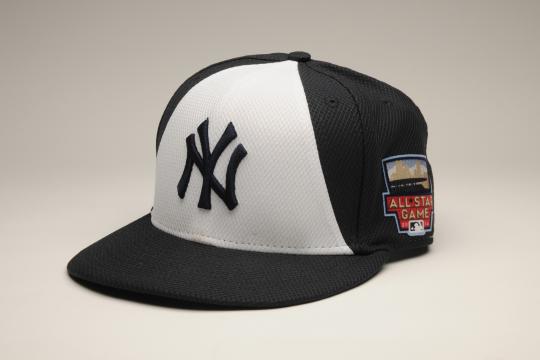Hall of Fame Weekend Brings Out Our Love for the Game
Football on 17 Sundays in the fall is incredibly popular. But Baseball and its 162-game schedule remains our National Pastime. It continues to be front and-center in American culture. Music, books, film, television, theater, poetry, nomenclature, and even the Oval Office borrow from baseball. As an everyday part of our lives, baseball has helped to shape, and in some cases define, American culture and values.
The Cooperstown museum contains 50,000 square feet of public galleries, theaters and activity spaces. It is truly a state-of-the art living, breathing, experiential history museum, using baseball as a lens to demonstrate how baseball and America have grown up together since Abraham Lincoln, was in office.
The modest three-story red brick building on Main Street house three entities under one roof. A Museum & Library, dedicated to documenting and presenting baseball history; an education hub, which reaches school children in all 50 states, Canada and Latin America every year, and; a Hall of Fame, a shrine to the game’s legends.
Our mission is straight-forward: Preserving history, honoring excellence and connecting generations. These six words have served to guide the venerable home to baseball since the get-go.
From the legendary baseball purportedly used by Abner Doubleday In 1839, to Ty Cobb’s spikes, to Roberto Clemente’s 3000th hit bat to the caps Derek Jeter and Mike Trout wore in this year’s mid-summer Classic, baseball’s magnificent history is front and center.
Generations are seamlessly connected. It’s not unusual to find a grandparent, parent and child meandering through the Museum and chatting quietly. The youngster will blurt out, “David Ortiz is the greatest. The father will quip, “but you never saw Wade Boggs play. And grandma will chime in, “but Teddy Ballgame was the best of them all.” Three generations. One language. Baseball.
Excellence is honored annually through induction. This year, managers Bobby Cox, Tony La Russa and Joe Torre were enshrined, along with 300-game winners Tom Glavine and Greg Maddux, and slugger Frank Thomas. With their inclusion, the Hall of Fame honor rolls now stands at 306. Umpires, executives and Negro leagues legends comprise the balance of those recognized with a bronze plaque.
For players, earning election to the Hall of Fame is not an easy task: only 1% of the 18,000 or so men to have worn a major league uniform have been honored. There are plaques for 211 players. Managers? There are now all of 22. That’s it.
For many of the 66 living Hall of Famers, returning for Hall of Fame Weekend each summer is meaningful, for a variety of reasons. They love returning to their home away from home. “Everything slows down in Cooperstown,” said Andre Dawson. “That’s what I love about being here.”
Hall of Fame Weekend is a great family weekend. Many Hall of Fame members bring their wives, children, grandchildren and friends. The baseball community attends in full force. Dignitaries. Regular fans. Everyone seemingly wants to rub elbows with greatness, experience the innate beauty of Cooperstown and fully enjoy the aura of a time not forgotten.
The camaraderie matters a great deal. Robin Yount considers his Hall of Fame colleagues teammates now: “Coming to Cooperstown is like being back in the clubhouse again. It’s a great feeling.”
One would imagine that the egos would be sizable among the Hall of Famers, given the enormity of their career accomplishments. Not the case. Egos are kept in check, as the common thread among them all is humility, with Cooperstown being the great equalizer. There’s no one bigger in the room. They are ALL big. And they are all respectful.
Tom Glavine and his family arrived in Cooperstown and walked into the Otesaga Resort Hotel, the Hall of Fame’s headquarters for the Weekend each year. “Hey dad! There’s Ozzie Smith over there. Look! Robin Yount! Check out all these guys. This is awesome! What are they doing here?” Tom just smiles and tells his kids that he too, is now one of them, hardly believing that is possible.
Glavine wasn’t sure what it would be like to meet Nolan Ryan and Bob Gibson. “Their personas on mound were tough. I was a bit nervous. Both could not have been more welcoming.”
After Bruce Sutter was elected in 2006, I would check in with him periodically by telephone in the ensuing months. “Every time I look at the phone and see the 607 area code, I think you are calling to tell me you recounted and I am out,” All I could do was smile and assure him that his election was very real.
I always enjoy my conversations with Paul Molitor. This year we were talking about the passing of Tony Gwynn, which hit us both like a ton of bricks. I confessed that among my favorite stats from Tony’s career were his 297 3-hit games juxtaposed one career three-strikeout game. To which Molitor responded, “Can you believe Tony could have gone 0-1200 and still had a .300 career average?” (It is actually 0-1182).
On Sunday at noon, the Hall of Fame members gather in the lobby of the Otesaga, to get ready to head to the Induction site. It is always a veritable “whose who” in baseball, and often, the guest list can rival the star power.
Tom Brokaw, a legend in his own right, and the man who wrote the forward to the Hall of Fame’s 75th anniversary compendium, ‘The Hall’ said, “As an American Legion shortstop who couldn’t get his girlfriend to a game, much less a scout, I was Walter Mitty all weekend,” referring to novelist James Thurber’s fictional mild-mannered character who lived a life of fantasy.
There’s no Starbucks in Cooperstown (we do have Stagecoach Coffee, a fabulous local bistro), but Howard Schultz made the trip with his son, Jordan, as guests of La Russa. “You look across the room and see Sandy Koufax AND Al Kaline. Meeting them was humbling.”
And the great Billy Crystal, whose passion for baseball is well documented, adds, “It was like my baseball cards came to life. Shaking hands with Gaylord Perry and joking ‘how come your hand is dry?’ and him saying, " ’Cause I'm not pitching." To chat with Ernie Banks, and see Koufax talking to Marichal and watching all these greats love being with each other, is a beautiful thing to be a part of.”
As the clock moved closer to show time, we made our way on to the buses, which would take us to the Clark Sports Center, home of the Induction Ceremony. I sat behind Maddux, in front of Glavine, and next to Kaline.
Mike Schmidt and I were in the Hall of Fame Plaque Gallery on Friday morning for a Golf Channel program being filmed with Johnny Bench, Glavine and him. As we stood by his plaque, I asked him what he was thinking about. “The speech. I am still consumed by how nervous I was.” His speech was delivered in 1995.
Yogi Berra was not able to attend this year. When I asked him if he wanted me to tell Torre anything, he said, ”tell him good luck, And keep it short.”
This year’s class had an audience of 48,000 fans in front of them and 48 Hall of Fame members behind them. Maddux found the experience humbling. Tony LaRussa asked if it was possible to be “de-ducted.” After the Ceremony, Torre, who had passed Miller Huggins on the Yankee all-time managerial win list during his tenure in the South Bronx, received a text stating “Thanks for not mentioning me. Miller.” It was from Crystal.
With speeches delivered, it was time to gather for the team photo on the Otesaga’s back lawn. Glavine sees Seaver and smiles, relieved his speech is over. Said #41: “Not so fast. It’s not official until your plaque is hung in the gallery, Mr. Glavine.” Seaver, by the way, always stops by the plaques of Christy Mathewson and Walter Johnson when he visits Cooperstown. “Good to see you boys,” he says, as he rubs their hats.
For Johnny, it’s another visit to the mound. And for the newest members of the Baseball Hall of Fame, it’s the capstone to a new way of life. That of a Hall of Famer.
Jeff Idelson is the president for the National Baseball Hall of Fame and Museum







